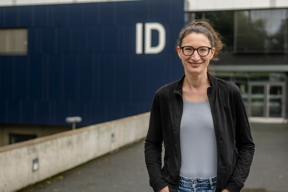Home > Press > Ultrafast lasers for materials processing
 |
| In addition to her ERC Starting Grant, Clara Saraceno receives a Proof of Concept Grant from the European Research Council.
CREDIT RUB, Marquard |
Abstract:
Lasers are an essential tool for materials processing. They can be used to cut, weld and remove material. A special kind of lasers known as femtosecond lasers can be used to create high-precision microstructures, such as those needed for smartphone displays and automotive technology. Professor Clara Saraceno from Ruhr University Bochum aims to introduce a cheaper and more efficient laser technology to the market. To this end, she is receiving a proof-of-concept grant amounting to 150,000 euros from the European Research Council (ERC). The project titled Ultrafast 2.1 µm Holmium Lasers for GHz ablation (Giga2u) will run for 18 months.
Ultrafast lasers for materials processing
Bochum, Germany | Posted on August 11th, 2023
Faster and more efficient
Standard femtosecond lasers emit light pulses with wavelengths of one micrometer and a duration in the hundreds of femtosecond range; this is the equivalent of a quadrillionth of a second. The energy per pulse is high, and the systems are expensive. New lasers that are faster and more efficient, while generating lower costs, could be a key technology for the market, points out Clara Saraceno, head of the Photonics and Ultrafast Laser Science group.
As part of her ERC Starting Grant TerAqua, Clara Saraceno is currently developing femtosecond lasers that operate at wavelengths of 2.1 microns and with repetition frequencies in the GHz regime. They require less energy and are potentially more reliable than systems currently deployed in industry. They also promise lower costs and faster production speeds. So far, however, the systems have only been used for research applications, such as spectroscopy.
Testing market readiness
The Giga2u proof-of-concept grant is intended to demonstrate the potential of the technology for industrial applications. Such a system would be of interest primarily for processing glass and polymers, but also for ablating aqueous tissues. The latter could be useful for future directions in laser surgery application. The researchers headed by Clara Saraceno hope to develop a compact and stable laser prototype and explore the technologys market potential. In the process, the group also intends to lay the groundwork for establishing a start-up.
####
For more information, please click here
Contacts:
Media Contact
Meike Driessen
Ruhr-University Bochum
Office: 49-234-32-26952
Expert Contact
Prof. Dr. Clara Saraceno
Photonics and Ultrafast Laser Science, Faculty of Electrical Engineering and Information Technology, Ruhr University Bochum, Germany
Office: +49 234 32 23027
@ruhrunibochum
Copyright © Ruhr-University Bochum
If you have a comment, please Contact us.
Issuers of news releases, not 7th Wave, Inc. or Nanotechnology Now, are solely responsible for the accuracy of the content.
News and information
![]()
Femtosecond laser technique births “dancing microrobots”: USTC’s breakthrough in multi-material microfabrication August 11th, 2023
![]()
USTC achieved dynamic imaging of interfacial electrochemistry August 11th, 2023
![]()
Simple ballpoint pen can write custom LEDs August 11th, 2023
Possible Futures
![]()
USTC achieved dynamic imaging of interfacial electrochemistry August 11th, 2023
![]()
Simple ballpoint pen can write custom LEDs August 11th, 2023
![]()
Chloride ions from seawater eyed as possible lithium replacement in batteries of the future August 11th, 2023
Discoveries
![]()
Simple ballpoint pen can write custom LEDs August 11th, 2023
![]()
Chloride ions from seawater eyed as possible lithium replacement in batteries of the future August 11th, 2023
![]()
Tattoo technique transfers gold nanopatterns onto live cells August 11th, 2023
Materials/Metamaterials/Magnetoresistance
![]()
Understanding the diverse industrial applications of materials science: Materials Science A Field of Diverse Industrial Applications July 21st, 2023
![]()
A non-covalent bonding experience: Scientists discover new structures for unique hybrid materials by altering their chemical bonds July 21st, 2023
![]()
Researchers put a new twist on graphite July 21st, 2023
Announcements
![]()
Simple ballpoint pen can write custom LEDs August 11th, 2023
![]()
Chloride ions from seawater eyed as possible lithium replacement in batteries of the future August 11th, 2023
![]()
Tattoo technique transfers gold nanopatterns onto live cells August 11th, 2023
Interviews/Book Reviews/Essays/Reports/Podcasts/Journals/White papers/Posters
![]()
Simple ballpoint pen can write custom LEDs August 11th, 2023
![]()
Chloride ions from seawater eyed as possible lithium replacement in batteries of the future August 11th, 2023
![]()
Tattoo technique transfers gold nanopatterns onto live cells August 11th, 2023
Photonics/Optics/Lasers
![]()
University of Chicago scientists invent smallest known way to guide light: 2D optical waveguides could point way to new technology August 11th, 2023
![]()
Femtosecond laser technique births “dancing microrobots”: USTC’s breakthrough in multi-material microfabrication August 11th, 2023
![]()
Two types of ultrafast mode-locking operations generation from an Er-doped fiber laser based on germanene nanosheets July 21st, 2023










